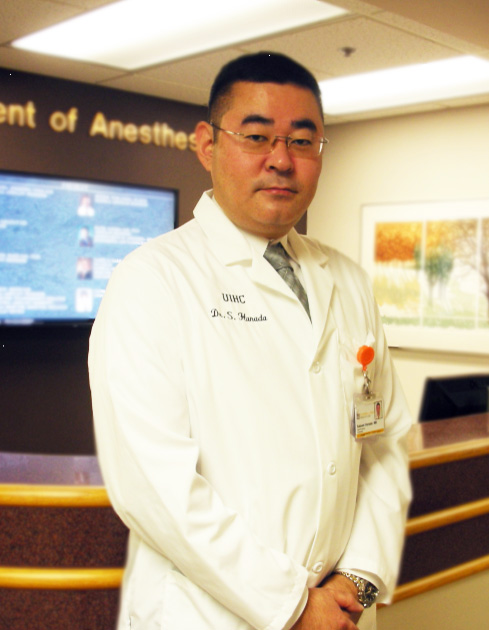Faculty Focus: Satoshi Hanada, MD
 What is your hometown?
What is your hometown?
My hometown is Fukuoka City, Japan. Fukuoka City is the capital city of Kyushu Island in the southern part of Japan.
How/when did you become interested in science and/or medicine?
Unlike the typical system in the United States, medical school in Japan is a six-year program after high school. I jumped into medical school when I was just 18 years old. At that age, I was too young to know what it meant to be a physician. I didn’t have any close relative or acquaintance who worked in the healthcare industry, so I could not easily imagine being a physician. However, I liked studying biology and I thought being a physician was a unique opportunity to learn biology and put that knowledge into practice. During my last year of high school, I was determined to go to a medical school.
When did you join the University of Iowa faculty?
I joined the University of Iowa as faculty in 2011 after I completed my one-year cardiothoracic anesthesia fellowship here.
Is there a teacher or mentor who helped shape your career?
I have many teachers and mentors who helped me grow professionally. I would like to share stories of two great mentors before I came to University of Iowa Hospitals & Clinics. Mr. Iwakuma was my Kendo teacher. Kendo is a traditional Japanese martial art. In my youth, I practiced Kendo intensively. Mr. Iwakuma held the highest degree of Kendo level (8-dan). He was a strict teacher and he disciplined me through the daily Kendo practice. With his mentorship, I was a captain of the varsity team at the university and led our team to win numerous championships. My experience through Kendo significantly influenced the development of my personality. I learned values of being patient, perseverant, and respecting others.
Professor Morita was a chairperson at the Department of Anesthesia in Teikyo University. After I graduated from medical school, I moved to Tokyo where I met Professor Morita during residency. He was an enthusiastic teacher and constantly inspired me to train in the United States. He was the reason I chose my specialty.
Mr. Iwakuma and Professor Morita are just two examples of many mentors who have helped me become the physician I am today.
How or why did you choose to join the faculty at the University of Iowa?
My one-year cardiothoracic anesthesia fellowship at University of Iowa was intense. I experienced hundreds of complex cardiac cases in both pediatric and adult populations, including heart and lung transplantation, left ventricular assist device implantation, and congenital heart disease operation. An anesthesiologist is not only administering anesthetic to the patients, but also managing the hemodynamics, which can rapidly change during heart and lung surgery. I was dealing with challenging operations on a daily basis. My fellowship experience, under the instruction of Dr. Alan F. Ross, fellowship director, and Dr. Javier H. Campos, director of cardiothoracic anesthesia, was so precious and substantial. I deeply appreciate all of the teachers on the cardiothoracic anesthesia team who enthusiastically educated me. They were all my role models. University of Iowa molded me to become a better anesthesiologist and I was fortunate to continue to work with a great team.
How do you see your faculty role impacting medicine and/or science?
I believe that I am one of the pioneers who started using ultrasound-guided vascular cannulation. This is especially useful for patients with difficult vascular access. We conducted several randomized trials and validated the technique with higher success rates for venous and arterial cannulation among both the pediatric and adult population. Then we developed a novel approach using a dynamic ultrasound-guided short-axis needle tip navigation technique, which further increased the cannulation success rate to nearly one hundred percent. It is becoming a popular technique at University of Iowa Hospitals & Clinics and it contributes to providing safer and more efficient anesthetic care to our surgical patients.
What is the biggest change you've experienced in your field since you were a student?
One of the biggest changes in my field is the emergence of the fast-track recovery strategy for cardiac surgery patients. A-high-dose opioid-based general anesthesia technique was traditionally used as a standard cardiac anesthesia to stabilize the intraoperative hemodynamics. However, this technique significantly prolongs recovery time. In order to expedite recovery, as well as to meet the demand of an increasing number of cardiac cases with limited medical resources, fast-track cardiac surgery has gained much popularity. It can be achieved by providing regional anesthesia and/or by judicious opioid use intraoperatively. Minimally invasive cardiac surgery (MICS) also can be performed with small incisions without a full sternotomy to facilitate a faster recovery; however, it requires special skills for both the surgeons and anesthesiologists.
What one piece of advice would you give to today's students?
My advice to students is to find role models who you want to be like in the future. They can help you become a better physician as they did for me. They can answer questions and guide you along the way.
In what ways are you engaged in professional activities outside the University (i.e., population-based research, mentoring high school students, sharing your leadership/expertise with organizations or causes, speaking engagement off campus, etc.)?
I invited physicians from various institutions in Japan to the University of Iowa, where they gain a unique and distinctive experience. Because my life and medical training began in Japan, I can readily connect with them about the transitions in practice, lifestyle, and culture that they experience while visiting Iowa. I also serve as a resource to support their involvement in research projects during their visit. My hope is that they would utilize the skill and knowledge they learned here and apply them back in Japan.
What are some of your outside (personal) interests?
I love fishing. I enjoy fresh seafood, including sushi and sashimi.
Learn more about Satoshi Hanada, MD.